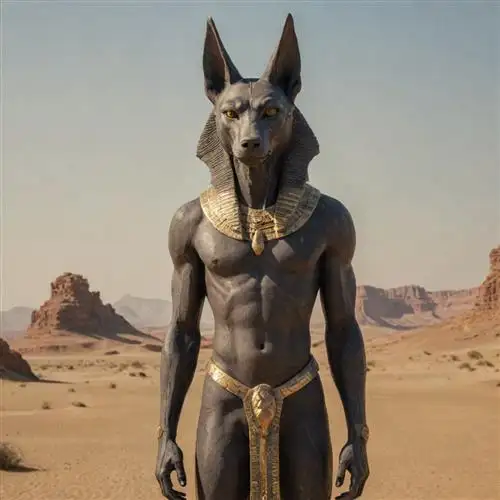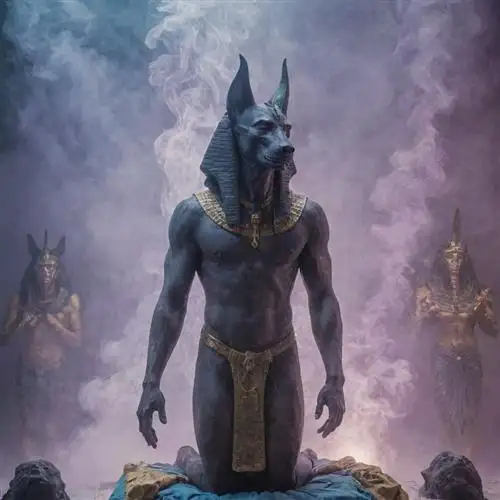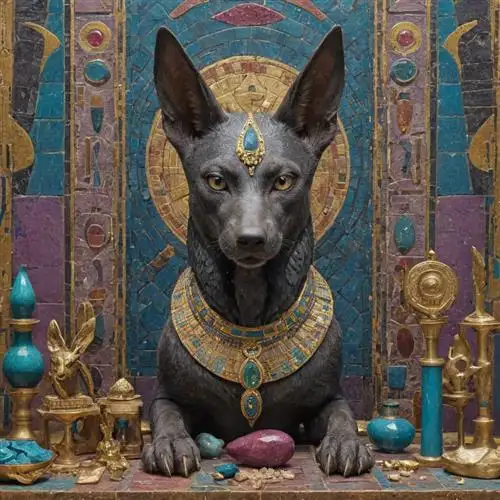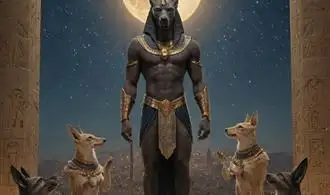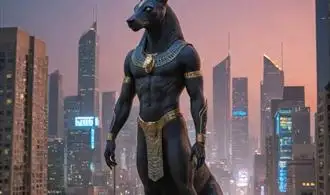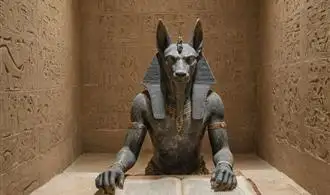
The Jackal-Headed God Anubis
Anubis, the enigmatic jackal-headed deity, has captivated the imagination of scholars and enthusiasts alike for centuries. As one of the most prominent figures in the ancient Egyptian pantheon, Anubis held a crucial role in the afterlife and the funerary rituals that were essential to the ancient Egyptians' beliefs.
At the heart of Anubis' symbolism lies the jackal, a creature that was deeply revered and associated with the necropolis, the ancient Egyptian city of the dead. The jackal's nocturnal nature and its scavenging habits, particularly its tendency to frequent cemeteries and gravesites, made it a natural choice for the deity tasked with guarding the dead and presiding over the mummification process.
Anubis' primary responsibilities included overseeing the embalming and mummification of the deceased, ensuring the safe passage of the soul into the afterlife, and guiding the dead through the treacherous underworld. As the patron of the necropolis, Anubis was believed to be present at the weighing of the heart ceremony, where the deceased's heart was weighed against the feather of truth to determine their worthiness for the afterlife.
The iconography associated with Anubis is rich and varied, with the deity often depicted as a jackal-headed human or a fully anthropomorphic figure. In some instances, Anubis was also represented as a pure jackal, reflecting the animal's close connection to the deity. The color black, which was symbolic of the embalming process and the fertile soil of the Nile, was closely associated with Anubis, further emphasizing his role in the afterlife journey.
Beyond his funerary responsibilities, Anubis was also believed to have played a significant role in the protection of the living. As a guardian deity, Anubis was invoked to safeguard individuals from the dangers of the night, as well as to ensure the safety of the deceased during their passage to the afterlife.
Anubis and the Underworld
Anubis, the jackal-headed god of ancient Egypt, holds a profound significance in the realm of the Underworld. As the guardian of the necropolis and the embalming process, Anubis played a crucial role in the afterlife journey of the deceased.
One of the primary responsibilities of Anubis was the mummification of the dead. The ancient Egyptians believed that the preservation of the physical body was essential for the soul's successful transition into the afterlife. Anubis, with his keen knowledge of the embalming techniques, would oversee the intricate process of mummification, ensuring that the deceased was prepared for the journey ahead.
Furthermore, Anubis was believed to be the guide of the dead, accompanying the souls of the deceased to the Hall of Judgment. In this sacred chamber, the heart of the individual was weighed against the feather of truth, represented by the goddess Ma'at. Anubis played a crucial role in this process, ensuring the fairness and accuracy of the judgment, ultimately determining the fate of the soul.
The underworld, known as the Duat, was a complex and multifaceted realm where Anubis reigned. This vast and mysterious domain was believed to be the resting place for the souls of the dead, as well as a place of transformation and rebirth. Anubis, as the gatekeeper of the Duat, was responsible for guiding the deceased through the intricate passages and obstacles of the underworld, ensuring their safe passage to the afterlife.
In addition to his role as the guide and protector of the dead, Anubis was also associated with the rituals and ceremonies surrounding death and burial. The ancient Egyptians believed that Anubis had the power to ward off evil spirits and ensure the safety of the deceased in the afterlife. As such, Anubis was often depicted in funerary art and iconography, serving as a symbolic guardian and protector of the dead.
Anubis as a Guardian and Protector
Anubis, the enigmatic jackal-headed deity of ancient Egyptian mythology, has long been revered as a guardian and protector. This enigmatic figure played a crucial role in the afterlife journey of the deceased, ensuring their safe passage and guiding them through the treacherous realms of the underworld.
As a guardian, Anubis was responsible for overseeing the mummification process, a sacred ritual that prepared the deceased for their journey to the afterlife. He was believed to preside over the embalming table, carefully tending to the body and ensuring that the soul was properly preserved. This meticulous attention to detail was essential, as the ancient Egyptians believed that the physical form was intrinsically linked to the soul's well-being in the afterlife.
But Anubis's role as a guardian extended far beyond the embalming process. He was also believed to accompany the deceased on their journey to the underworld, protecting them from the dangers and obstacles they might encounter. In the Hall of Judgment, Anubis was responsible for weighing the heart of the deceased against the feather of Ma'at, the goddess of truth and justice. This pivotal moment determined the soul's worthiness to enter the afterlife, with Anubis ensuring that the scales were balanced and the deceased's deeds were judged fairly.
Furthermore, Anubis was revered as a protector of the living as well. He was believed to have the power to ward off evil spirits and to safeguard individuals from harm. In this capacity, Anubis was often invoked in funerary rites and ceremonies, with his image appearing on amulets, stelae, and other objects meant to provide protection and guidance to the deceased.
The significance of Anubis as a guardian and protector is further underscored by his association with the process of mummification. The jackal-headed deity was believed to have the power to prevent the decay of the physical body, ensuring that the soul had a suitable vessel to return to in the afterlife. This belief in the importance of preserving the physical form was a cornerstone of ancient Egyptian theology, and Anubis's role as the overseer of this process was integral to the culture's understanding of the afterlife.
The Iconography and Symbolism of Anubis
Anubis, the jackal-headed Egyptian deity, holds a profound and multi-layered symbolic significance within the ancient Egyptian pantheon. As the god associated with mummification, death, and the afterlife, Anubis's iconography and symbolism are deeply intertwined with the Egyptian belief system and the rituals surrounding the transition from life to the hereafter.
One of the most recognizable aspects of Anubis's iconography is his distinctive jackal or canine head. This distinct feature is believed to represent the animal's keen sense of smell, which was essential in the mummification process. Jackals were often seen near burial sites, scavenging for carrion, and this association led to Anubis being viewed as the guardian of the dead and the protector of the mummification ritual.
The black color of Anubis's skin is also highly significant, as it symbolizes the color of the fertile soil along the Nile River, which was essential for the growth and rejuvenation of life. This connection to the cycle of life and death is further emphasized by Anubis's role as the guide and protector of the deceased, helping them navigate the treacherous path to the afterlife.
Anubis's iconography also includes the distinctive jackal-headed staff or scepter, which he is often depicted holding. This staff represents his authority and power over the processes of mummification and the afterlife. Additionally, Anubis is sometimes shown holding the "Ankh" symbol, which represents the key to life and the afterlife, further emphasizing his role as the guardian and facilitator of the transition between the two realms.
In addition to his primary role as the god of mummification and the afterlife, Anubis was also associated with other important aspects of Egyptian beliefs and rituals. He was believed to weigh the heart of the deceased against the feather of truth, determining their worthiness to enter the afterlife. This "weighing of the heart" ceremony was a crucial part of the funerary rites and the journey to the afterlife.
Anubis's symbolic importance is further reflected in his association with various other deities, such as Osiris, the god of the underworld, and Isis, the goddess of magic and rebirth. These interconnections highlight the complex and multifaceted nature of Anubis's role within the Egyptian pantheon and the broader cultural and religious context.
Anubis in Modern Mythology and Popular Culture
Anubis, the jackal-headed Egyptian deity, has captivated the imagination of modern audiences, transcending the boundaries of ancient mythology and weaving its way into popular culture. As a symbol of death, rebirth, and the afterlife, Anubis has remained a potent and enduring figure, capturing the fascination of artists, writers, and enthusiasts alike.
One of the most significant ways Anubis has found expression in modern mythology is through its representation in fiction and media. The Egyptian god has been a recurring character in various forms of storytelling, from literature to film and television. Authors have often utilized Anubis as a central figure in narratives exploring themes of mortality, the afterlife, and the mysteries of ancient civilizations.
In the realm of literature, Anubis has appeared in the works of renowned authors such as Neil Gaiman, who incorporated the deity into his acclaimed novel "American Gods." In this work, Anubis serves as a guide and protector for the dead, navigating the complex landscape of the afterlife. Similarly, the character of Anubis has been featured in the Percy Jackson and the Olympians series by Rick Riordan, where the god plays a crucial role in the protagonist's journey and the exploration of ancient Egyptian mythology.
The visual arts have also been a canvas for the representation of Anubis. Contemporary artists have leveraged the iconic figure of the jackal-headed god to explore themes of death, spirituality, and the human condition. From paintings and sculptures to digital art, Anubis has been reimagined and reinterpreted, often juxtaposed with modern symbols and iconography to create thought-provoking and visually striking works.
In the realm of popular culture, Anubis has found a prominent place in video games, where the deity's mythological significance and visual appeal have been cleverly incorporated into immersive gaming experiences. Games such as the Assassin's Creed series and the Tomb Raider franchise have featured Anubis as a central character or as a prominent narrative element, allowing players to delve into the rich tapestry of ancient Egyptian mythology.
Moreover, the enduring popularity of Anubis has also manifested in the realm of fashion and design. The jackal-headed god has been a source of inspiration for various fashion collections, with designers incorporating Anubis-inspired motifs and imagery into their creations. Additionally, the iconic figure of Anubis has been featured on a wide range of merchandise, from t-shirts and accessories to home decor and jewelry, further cementing its place in contemporary popular culture.

